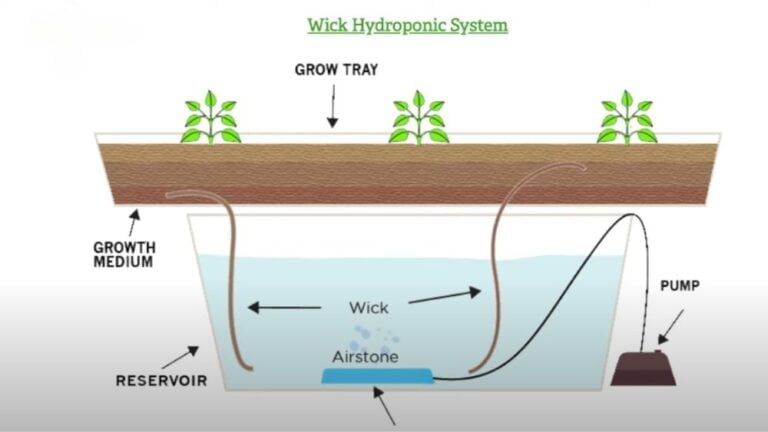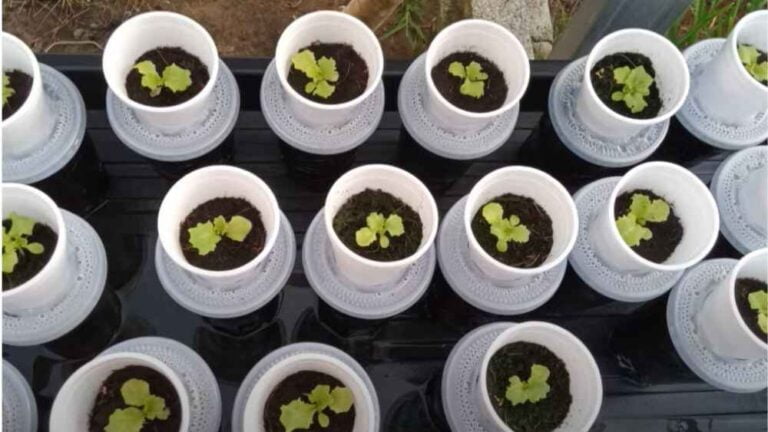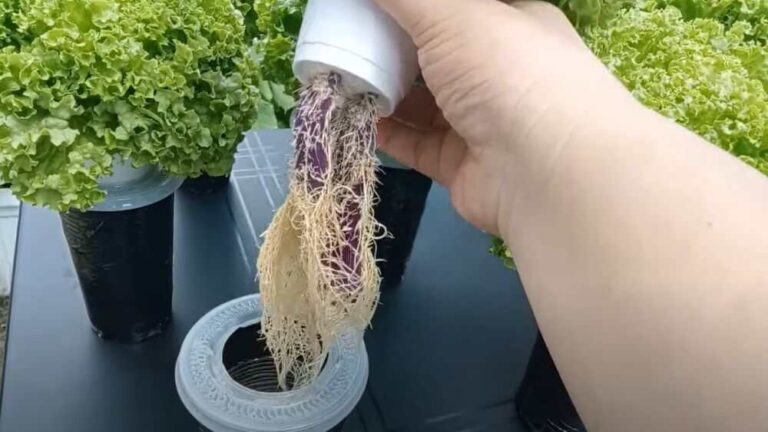Wick System Hydroponics: How to Build Your Own Setup at Home
Dive into the fantastic realm of hydroponics, where we ditch the soil and embrace a gardening revolution transforming how we grow! Whether you’re a curious newbie or someone eager for an easy and budget-friendly start, you’ve landed in the right spot.
We’re exploring the world of Wick System Hydroponics here; it’s ideal for beginners and a fantastic choice if you’re testing the waters of hydroponic gardening. Imagine growing your kitchen herbs or engaging in a fun, educational project with your kids. Crafting your wick system hydroponic setup at home is not just profoundly satisfying; it’s a journey packed with rewards. Let’s get.

What is Wick System Hydroponics?
Let’s dive into wick systems, a beautifully simple and passive approach to hydroponics. Imagine a system where a humble wick plays the hero, effortlessly carrying water and nutrients from a reservoir right to the heart of your plant’s growing medium.
This system is a dream for enthusiasts who prefer a hands-off approach, especially those just starting or dabbling in small-scale gardening with herbs and petite plants. Unlike its high-tech cousins with their pumps and timers, the wick system is a breath of fresh air in convenience.
Why Consider a Wick System? Let’s weigh the pros and cons!
Pros:
- Easy-Peasy Setup: Setting up a wick system is a breeze, even if you’re not a tech whiz. It’s like putting together a jigsaw puzzle where all the pieces fit perfectly.
- Wallet-Friendly: Dive into hydroponics without breaking the bank. The materials you need are affordable and easy to find, making this a budget-friendly gardening adventure.
- Chill and Relaxing Maintenance: Forget about complex wiring or pump hum. This system runs quietly in the background, letting you focus more on enjoying your garden than maintaining it.
Cons:
- Small but Not Mighty: Planning to feed an army with your hydroponic setup? There might be a better bet than this. Wick systems are better for smaller, less thirsty plants.
- Nutrient Nudging Needed: At times, the wick needs some help to spread those nutrients evenly. You might need to step in and act as a nutrient cop occasionally.
Perfect Plant Partners for Wick Systems
Have you ever dreamed of growing your own lettuce or a fragrant herb garden with basil and mint? Small ornamental flowers can also find a happy home in a wick system. These plants thrive in this setup, making it an excellent choice for greening up your space with ease and simplicity.

Materials Needed for a DIY Wick System Hydroponic Setup
Wick watering systems are an adventure; having the right gear is critical to success! Consider yourself a plant-parent chef, gathering ingredients for the most effective growth recipe. Here’s what’s on your shopping list:
The reservoir
Think of this as your nutrient soup bowl. It could be a simple plastic container or a fancy hydroponic reservoir—it’s your call!
Growing Medium
This is where your plants will root. You’ve got some excellent choices, like coconut coir, perlite, or vermiculite. Each is like a comfy bed for your plants on this hydroponic journey.
Wicks
These lifelines draw nutrient-rich moisture to your plants. Cotton or polyurethane are both excellent choices for wicks that are thirsty.
Plant Nutrients
It’s like picking the right vitamins for your plants. Grab a well-balanced hydroponic nutrient mix from a trusted source and watch your plants gulp down those essential minerals.
Grow Trays/Pots
Your plants need a home, and these trays or pots are just that. They hold everything together—the growing medium and your green babies.
Air Pump (Optional)
This isn’t a must-have, but consider it a luxury spa feature for your plants. An air pump can add oxygen to the water, making for happier, healthier roots.
pH Meter
It’s like a health check-up tool for your nutrient solution. Keeping the pH in check is crucial for your plants’ well-being.
Most of these items are just a garden store visit or online order away. You can create your hydroponic garden in your own home by assembling these elements like puzzle pieces!

Step-by-Step Guide: Building Your Wick System Hydroponic Setup
Creating your own Wick System hydroponic setup is easier than you think, and you don’t have to be a gardening expert!
Step 1: Prep Time!
First things first, find a breezy, clean spot and get all your tools and materials ready. Remember, cleanliness is vital. Wash those hands and slip on some gloves!
Step 2: Water World
Grab your reservoir and fill it with water. Whip out your pH meter and play scientist; you want the water’s pH to range between 5.8 and 6.3.
Step 3: A Cozy Bed for Your Plants
It’s time to get your grow trays or pots and fill them with the growing medium of your choice. Here is a heads-up: don’t pack it too tight!
Step 4: Wick Away!
Now, carefully place the wicks in the growing medium. Think of them as little straws, sipping up the nutrient-rich water to feed your plants.
Step 5: Planting Party
Get your seeds or seedlings ready and nestle them in the growing medium. Just correct depth and shallowness!
Step 6: Nutrient Magic
Follow the instructions on your nutrient solution package and mix it up. Pour it into the reservoir, making sure those wicks are thoroughly soaking it up.
Step 7: Keep It Groovy
Keep an eye on your setup. Regular checks on nutrient levels, pH, and water volume are crucial. Top up as needed to keep things running smoothly.
Step 8: Problem-Solving
Stay alert for trouble signs, like yellow leaves or sluggish growth. Spot something off? Tweak your nutrient solution to get things back on track.
A little heads-up: I’ve pulled together this guide based on thorough research and chats with hydroponic whizzes. But remember, every plant whisperer’s journey is unique; don’t hesitate to reach out to experienced growers or agricultural experts for tailor-made advice. And, of course, always play by the rules and follow local guidelines when setting up your hydroponic wonderland.

Tips for Maximizing Plant Growth in Your Wick System
Diving into Wick System hydroponics is a thrilling journey. Achieving lush, vibrant growth in your plants is totally possible with a bit of insider knowledge. Let’s break down these pro tips for a flourishing hydroponic garden:
The Magic of Nutrients
Think of nutrient solutions as the lifeblood of your hydroponic setup. Go for top-notch, water-soluble fertilizers that cover all essential macro and micronutrients. Ensure the pH and nutrients are just proper to ensure they’re suitable for your green buddies.
Let There Be Light!
Sunlight is terrific, but some plants are sun worshippers and crave more. How about boosting their happiness with LED grow lights? Adjust the lighting hours to meet your plant family’s needs.
Creating the Perfect Climate
Finding that sweet spot between temperature and humidity is key. Most plants thrive at 65 to 75°F, with humidity hovering between 50-70%. A climate control system can be a game-changer here, taking the guesswork out of maintaining an ideal environment.
Oxygen–The Unsung Hero
Yes, the Wick System is a relatively simple hydroponic method. However, introducing an air pump to increase oxygen levels can improve nutrient absorption and root health.
Routine TLC:
Keep an eye on those wicks to avoid clogs, and refresh the nutrient solution often to prevent any nasty buildup or bacteria. Stay vigilant for pests and diseases, and tackle them organically whenever you can.
In a nutshell: Amp up your Wick System Hydroponics by focusing on nutrient balance, proper lighting, temperature control, and consistent care. Watch your plants thrive!
FAQs About Wick System Hydroponics
Can Any Plant Be Grown in a Wick System?
Ideal for herbs and small plants. It is not recommended for large plants with extensive root systems.
What Type of Wick Material Is Most Effective?
Cotton, felt, or nylon. They balance absorption and avoid root rot.
Is a Pump Necessary for Wick System Hydroponics?
Not necessary, but a pump can improve plant health by oxygenating the water.
Can I Use Tap Water for My Wick System?
Yes, you can use tap water, but if it’s complex or chlorinated, let it sit or filter it first.
Is Lighting Critical in a Wick System Hydroponics Setup?
Yes, adequate light, either natural or artificial, is crucial for plant growth.
What Is the Best Way to Know If My Plants Have Enough Nutrients?
Monitor plant color and growth; changes may indicate nutrient deficiencies.
Conclusion
Are you ready to dive into hydroponic farming? Look no further than Wick System Hydroponics! Perfect for beginners and light on the wallet, this method is your gateway to exploring the wonders of soilless gardening. You will be able to handle the complexities that other hydroponic systems might throw at you. Our guide is like having a friendly expert right beside you, walking you through each step of building your hydroponic garden at home. The process is a breeze, and you’ll find the materials you need are easy to get and easy on your budget. Imagine this: savoring fresh herbs and vibrant leafy greens right from your living room, and that too with just a tiny investment of time and effort. So, for all you budding gardeners eager to test the waters of hydroponics, starting with a wick system is an absolutely fantastic choice!
Additional Resources
Knowledge is power, especially when mastering a new skill. To enrich your hydroponic gardening experience, consider the following resources:
- Books and eBooks: Titles like “Hydroponic Basics” by George F. Van Patten and “Hydroponics: A Practical Guide for the Soilless Grower” by J. Benton Jones Jr. offer invaluable insights.
- Online Courses: Websites like Udemy and Coursera offer comprehensive hydroponic gardening courses suitable for all levels.
- YouTube Channels: “Epic Gardening” and “Jeb Gardener” provide step-by-step video tutorials and expert advice.
- Forums and Online Communities: Reddit’s/r/hydro and Hydroponic Gardening communities on Facebook are great platforms for sharing experiences and solving challenges.
Call to Action
If you’ve ever wanted to explore hydroponic gardening, there’s no time like now. By following this guide, you’re already one step closer to building your own Wick System hydroponic garden. So, why not leap? Gather your materials and carve out a small corner of your home for this exciting project. Whether you’re in a New York apartment or a Texas ranch, hydroponics knows no geographical bounds. Remember to share your journey and any questions in the comments section below. Your experiences could inspire a new wave of hydroponic enthusiasts across the United States.
Start growing, America!

Meet Milan Cole, your urban gardening pro!
Milan Cole, chief content writer at Maven Gardening and an urban gardening expert, is passionate about helping city dwellers cultivate their green thumbs. Armed with extensive horticultural knowledge, Milan provides practical advice for overcoming urban gardens’ challenges, like limited space, water scarcity, and reduced sunlight.
His expertise extends beyond traditional methods, encompassing innovative approaches like hydroponic and aquaponic systems and sustainable gardening practices. Milan skillfully adapts these techniques to urban environments, considering factors like pollution and climate change.
In his clear and concise writing, Milan offers actionable solutions for anyone wanting to bring life to an urban space. He shares valuable insights into growing herbs in tight spaces, maximizing the potential of window boxes, and transforming even the most miniature balconies into thriving green oases.
Milan’s guidance is straightforward and practical, making it ideal for anyone looking to cultivate their own urban garden, regardless of prior experience.
Join Milan Cole on your journey to metropolitan Eden!
